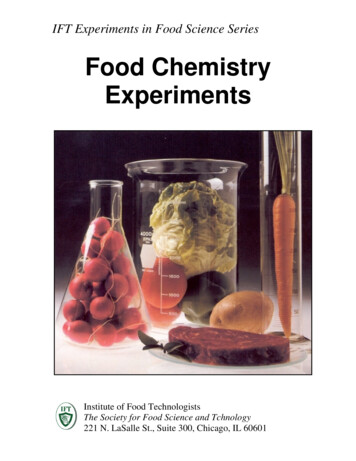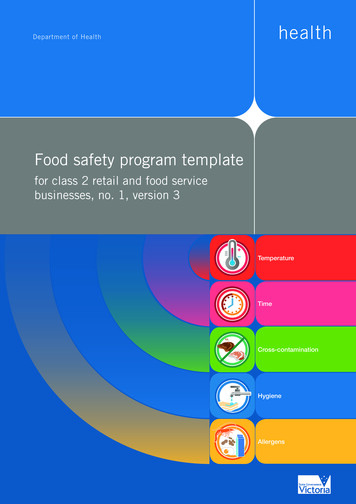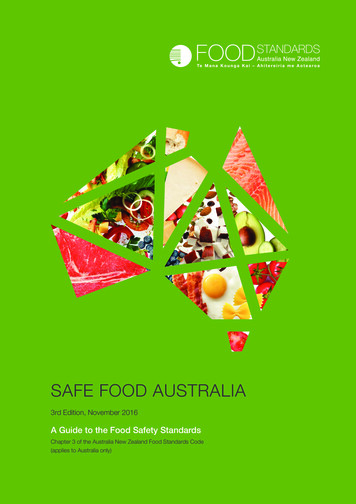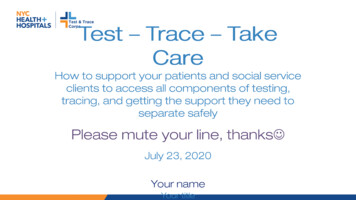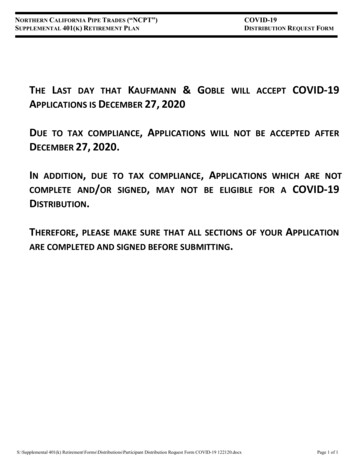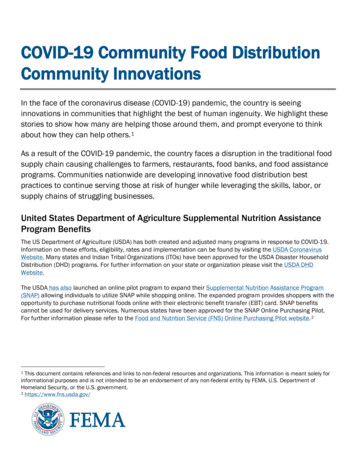
Transcription
COVID-19 Community Food DistributionCommunity InnovationsIn the face of the coronavirus disease (COVID-19) pandemic, the country is seeinginnovations in communities that highlight the best of human ingenuity. We highlight thesestories to show how many are helping those around them, and prompt everyone to thinkabout how they can help others. 1As a result of the COVID-19 pandemic, the country faces a disruption in the traditional foodsupply chain causing challenges to farmers, restaurants, food banks, and food assistanceprograms. Communities nationwide are developing innovative food distribution bestpractices to continue serving those at risk of hunger while leveraging the skills, labor, orsupply chains of struggling businesses.United States Department of Agriculture Supplemental Nutrition AssistanceProgram BenefitsThe US Department of Agriculture (USDA) has both created and adjusted many programs in response to COVID-19.Information on these efforts, eligibility, rates and implementation can be found by visiting the USDA CoronavirusWebsite. Many states and Indian Tribal Organizations (ITOs) have been approved for the USDA Disaster HouseholdDistribution (DHD) programs. For further information on your state or organization please visit the USDA DHDWebsite.The USDA has also launched an online pilot program to expand their Supplemental Nutrition Assistance Program(SNAP) allowing individuals to utilize SNAP while shopping online. The expanded program provides shoppers with theopportunity to purchase nutritional foods online with their electronic benefit transfer (EBT) card. SNAP benefitscannot be used for delivery services. Numerous states have been approved for the SNAP Online Purchasing Pilot.For further information please refer to the Food and Nutrition Service (FNS) Online Purchasing Pilot website. 2This document contains references and links to non-federal resources and organizations. This information is meant solely forinformational purposes and is not intended to be an endorsement of any non-federal entity by FEMA, U.S. Department ofHomeland Security, or the U.S. government.2 https://www.fns.usda.gov/1
Disaster Household Distribution ProgramThe Maryland Department of Human Services, in conjunction with the Maryland Food Bank and Capital Area FoodBank, is launching the Disaster Household Distribution Program for areas most impacted by the COVID-19pandemic. The program provides food packages for one and two person households including frozen items andpantry staples. Larger households are able to apply to receive multiple packages. The packages are filled withexisting supplies of USDA-purchased foods. 3RestaurantsSelling GroceriesMany restaurants nationwide are turning their stores into makeshift markets, utilizing their neighborhood networksto open up their pantries and supplies to customers. Items available include produce, meats, bakery items, preparedfoods and household staples. Major foodservice distributors began helping restaurants create these new minimarkets. A new website by Sysco named Sysco Pop Up Shop offers resources on how restaurants can get startedand grow their business to offer additional essential products. For additional tips on selling groceries fromrestaurants please visit the National Restaurant Association website. 4 5 6 7 8 9Selling Family MealsLocal, chain, and fast food restaurants across the country are offering family style meals. The meals generallyinclude enough food for two to four individuals. The food options are either ready-to-eat options or ingredients toprepare at home. 10 11 tions-newlyunemployed4 15 uspandemic/2113858/6 staurantmodel/#28d5fabe7a4e7 k8 /restaurant-grocery-sell-coronavirus/9 ce-market-andgrocer/10 estaurants11 antry-fatiguedfamilies/#5e7e7ec851ac12 13Learn more at fema.govJune 1, 2020 2 of 6
Providing Workers FoodMany restaurants have had to lay off workers due to the economic hardships of COVID-19. A restaurant inMontgomery County, Pennsylvania has been providing their former employees food. The restaurant is providingformer workers family-size portions to help them avoid the financial burden of buying groceries and meals. 13Food Trucks at Rest StopsTruckers have begun facing difficulty finding food for themselves on long journeys as many restaurants at highwayrest stops are either closed or operating with limited hours and drive-thru restaurants are not accessible to semitrucks. The California’s State Transportation Department allows food trucks to obtain a free permit to park athighway rest stops and sell food to truckers and others in need. 14Resources for Restaurants and BarsStreetsense, a company specializing in retail, restaurant, hospitality and real estate solutions has launched a toolkitto aid restaurant industry contacts in understanding, planning and mitigating the impacts of the COVID-19 pandemicto their establishments. The toolkit contains resources for managing capital, planning for relaunch and providesrecommendations on operation adjustments and increasing guest engagement. Individuals are able to sign up anddownload the report on the Streetsense Website. For additional tips on reopening restaurants please visit theNational Restaurant Association website. 15Farmers and Agriculture ProductionCommunity-Supported Agriculture ProgramsCommunity-supported agriculture (CSA) is a system through which individuals pay to regularly receive fresh producefrom nearby farms, sometimes with an option to also receive local meat and dairy. 16 CSAs provide groceries directto-consumer, allowing individuals to receive groceries at home instead of going to public supermarkets and riskingtheir health. Many CSAs allow for direct donations to local farmers who are facing financial difficulties during thepandemic. 17 In addition, decentralized and localized systems such as CSA’s are more resilient in the face ofdisruption and may help bolster our community’s food supply chain against future crises.Farmers to ConsumersAn increase in demand for fresh produce can has been demonstrated by a number of individuals purchasing m/15 /16 ering-groceriesplant-starts-covid-1917 /23/us-farms-csa-food-coronavirus1314Learn more at fema.govJune 1, 2020 3 of 6
to farms and online. Farmers have shifted from selling wholesale to direct to consumers. 18 Local farms in Chicagohave added the options of home delivery and contactless pick up points throughout the city. 19Farmers to Families Food BoxAs part of the Coronavirus Food Assistance Program (CFAP), USDA is now providing 19 billion in relief support forthe Farmers to Families Food Box Program. This program is intended to support farmers and ranchers, whilemaintaining the integrity of the food supply chain and ensure every American continues to receive and have accessto the food they need. The USDA also recently published Frequently Asked Questions for nonprofit organizationsengaged in food distribution and seeking to receive food through the Farmers to Families Food Box Program. 20Farms to Food BanksFarmers have partnered with organizations in New York to grow fresh produce and vegetables. The GoFundMe forthe group, called Farms to Food Banks, is raising money to buy truckloads of food from farmers to then be donatedto food banks in need in the New York area. This effort aims to both ease the financial burden farmers are facingand aid the undersupplied food banks. 21 22Pay for A Box and Donate a BoxIn Tampa Bay, a website has been set up where customers can pay for a box of fresh vegetables for themselves anddonate to the food bank at the same time. The content of the boxes changes weekly depending what foods areavailable. Boxes are available for delivery three days a week at local food banks, more information is available athttp://buyfarmfood.com. 23Nonprofit OrganizationsWorld Central KitchenWorld Central Kitchen, a mid-Atlantic based nonprofit organization, has served more than three million fresh mealsand is providing nearly 200,000 meals daily during the pandemic. In addition, World Central Kitchen founder andrestauranteur Chef Jose Andrés has transformed five restaurant locations into community kitchens, where he offersdiscounted meals for takeout daily and launched a bodega market at three restaurant locations to sell staple oduce-straight-to-chicagoans-doors04242020 ers-to-families-food-box21 th-bronxfamilies22 53891.html23 s-produceboxes/1819Learn more at fema.govJune 1, 2020 4 of 6
items and household goods. The World Central Kitchen has utilized sporting venues to prepare and distributethousands of free meals to those in need. 24Feeding Tampa BayFeeding Tampa Bay is donating pallets of fresh produce to the Tampa Metropolitan Area Young Man’s ChristianAssociation (YMCA) Veggie Van every Wednesday. The Veggie Van delivers fresh fruits, vegetables, and sweet treatsto individuals living in food deserts. A food desert is an area located at least one mile from the nearest supermarket,supercenter or grocery store in urban areas and more than ten miles in rural areas. The van creates a nutritionaland free mobile marketplace. The items are prepackaged and grab-and-go at no cost while still utilizing socialdistancing measures. 25Team Rubicon and Feeding America PartnershipDue to increased demand on food supplies and a shortage of manpower, Team Rubicon has partnered with FeedingAmerica to ensure that families in vulnerable communities get the food and supplies they need throughout thecourse of the COVID-19 pandemic. Team Rubicon volunteers, comprised mainly of veterans, provide the manpower,experience, and know-how to support food bank operations. They package food for distribution, deliver meals to thehomebound, coordinate logistics, organize fellow volunteers, and conduct warehouse management. 26Salvation Army and Meals on Wheels CollaborationTogether with Salvation Army in Baltimore, Maryland, Meals on Wheels of Central Maryland has provided 20,000meals to communities struggling with hunger. In collaboration with other National Voluntary Organizations Active inDisaster (VOAD) members, the Salvation Army is also coordinating service delivery and filling gaps. The SalvationArmy has 7,600 centers of operations which allows them to use facilities such as camps, warehouses, shelters andthrift stores to support the whole-community response in providing food, supplies, and manage donations. 27Food RetailersPublix Super MarketsA Publix Supermarket in Orlando, Florida is purchasing fresh produce and milk from local farmers and dairies todonate to Feeding America member food banks. The effort is aimed toward bridging the gap between the needs offamilies and farmers impacted by the COVID-19 pandemic. Publix plans for the effort to last several weeks. d0abd6825 deserts26 rtnership/27 https://www.salvationarmyusa.org/usn/covid19/28 earn more at fema.govJune 1, 2020 5 of 6
FEMA’s Best Practice InitiativeThere are extraordinary efforts nationwide to support personnel and resource needs to battle the COVID-19pandemic. FEMA is working to highlight these efforts and encourage everyone to think about what they can do to bea part of providing solutions to help. Visit https://www.fema.gov/coronavirus/best-practices for more information.Topics for the “Best Practices” series are generated from crowd-sourced suggestions. Have an idea? Let us researchit! Organizations and individuals can e-mail best practices or lessons learned to fema-cipsupport@fema.dhs.gov.For more information on how to help during COVID-19, visit FEMA’s website for information on donations andvolunteering.FEMA does not endorse any non-government entities, organizations, or services. Claims made by third parties havenot been independently verified by FEMA.Learn more at fema.govJune 1, 2020 6 of 6
The California's State Transportation Department allows food trucks to obtain a free permit to park at highway rest stops and sell food to truckers and others in need. 14. Resources for Restaurants and Bars Streetsense, a company specializing in retail, restaurant, hospitality and real estate solutions has launched a toolkit . plant-starts .






